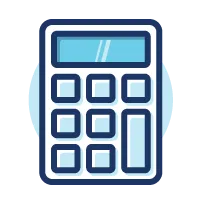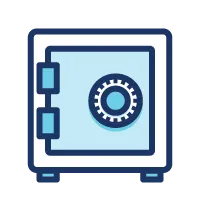What We'll Cover
- What a mortgage loan is
- Pros and cons of 6 types of mortgage loans
- Mortgage Insurance Premium
- Fannie Mae and Freddie Mac
When it comes to purchasing a home, there are many mortgage options available to you. These options depend on different factors, such as whether you're a first-time homebuyer, how much you’re willing to put down, and even where you live.
In this guide, you'll find six different mortgage options available for Arizona residents to help you decide which is best for you — especially if you’re a first-time homebuyer.
What is a Mortgage Loan?
A mortgage loan, or mortgage for short, is a loan from the lender that allows the borrower to purchase or refinance a home where the property serves as the collateral for the loan.
Since the majority of homebuyers do not have the cash on hand to purchase the full price of the home, the lender provides a lump sum to purchase the home and the borrower agrees to pay back both principal and interest to the lender over an agreed upon timeframe.
Mortgage Payment = Principal + Interest
Principal goes towards the loan balance and interest is paid to the lender. Use our mortgage calculator to see the total breakdown.
A mortgage loan is a secured loan, which means the lender will use the house as collateral for the loan. If the borrower fails to make the monthly payments towards the loan, the lender will repossess the home in a legal process known as foreclosure.
The 6 Types Of Mortgage Options in Arizona
Every mortgage program is structured a little bit differently to fit the needs of each unique homebuyer. Some mortgages require a larger down payment, others require a higher credit score and there are other mortgage loans that are guaranteed by the United States government.
Here’s a breakdown of the six mortgage options you have in the state of Arizona.
1. FHA Loans - Best for First-Time Homebuyers
First-time home buyers with a lower or moderate income typically utilize a Federal Housing Administration loan.
The FHA provides mortgage insurance to lenders who issue FHA mortgage loans. The government-backing on these mortgages decreases the risk for lenders, which also loosens the restrictions on obtaining a loan as compared to the requirements for a conventional mortgage.
How Does an FHA Loan Work?
FHA loans allow first-time homebuyers to get a mortgage with as little as 3.5% down and a lower credit score between 580 and 600. However, in some instances the borrower can go down to a 500 credit score with 10% down. Keep in mind, these limits also are dependent on the lender creating the loan.
Similar to private mortgage insurance you see with conventional loans, FHA loans have a mortgage insurance premium (MIP) added to the loan. Borrowers also have the option to choose between a fixed-rate mortgage versus an adjustable rate mortgage, and between a 15-year or 30-year loan term.
What is the Mortgage Insurance Premium?
The mortgage insurance premium (MIP) is built into all FHA loans and is broken down into two parts: the upfront mortgage insurance premium and the annual mortgage insurance premium.
Upfront mortgage insurance premium
Borrowers choosing an FHA loan will have to pay an upfront insurance premium of 1.75% of the loan amount. This can be paid as a closing cost or rolled into the mortgage loan.
For example, if a borrower is obtaining a loan for $350,000, the upfront insurance premium of 1.75% is $6,125. Keep in mind this would be in addition to the 3.5%, or the $12,250 minimum down payment.
Annual mortgage insurance premium
FHA loans will also require an annual mortgage insurance premium which is paid monthly. The amount ranges from 0.45% to 1.05% and is dependent on the loan amount and loan term.
A good rule of thumb is to add $40 to $90 per month for every $100,000 borrowed. For example, a $300,000 loan would require $120 to $270 MIP each month.
How Long Do I Pay the Mortgage Insurance Premium?
With FHA loans, the MIP is either paid for 11 years or for the life of the loan. When the borrower makes a down payment of 10% or more, MIP will last for 11 years. If less than 10%, then the borrower will pay the mortgage insurance premium for the life of the loan.
Pros of an FHA Loan
Since FHA loans have some of the loosest restrictions when it comes to obtaining a mortgage, they are very popular among first-time home buyers and those with credit score challenges.
- More lenient borrowing requirements. FHA loans allow access to a mortgage with low credit scores, little-to-no savings, and financial hardships (bankruptcy, foreclosure, etc.) in their recent past.
- Down payment gifts. Unlike a conventional mortgage, FHA loans allow the borrower to use gifted funds from family, employers or charitable organizations.
- No income limits. Unlike a USDA loan, there are no income limits to obtaining an FHA loan.
- Competitive interest rates. Unlike Fannie Mae or Freddie Mac, FHA loans do not gradually increase interest rates based on your credit score. Therefore, those with lower credit can still have access to some of the best rates.
- Assumable mortgages. FHA loans are unique in they are “assumable mortgages”. This means that if you sell the home, a buyer can simply take over the mortgage payments instead of obtaining a new loan.
Cons of an FHA Loan
- Annual mortgage insurance premium. Unlike a conventional loan, the MIP for an FHA loan has much more severe consequences. Depending on the down payment, borrowers will have to pay the insurance premium for 11 years or the life of the loan.
- Upfront mortgage insurance premium. In addition to a monthly insurance premium, FHA loans require a large upfront insurance premium of 1.75%.
- Loan limits. FHA loans have limits based on where you live. You can look up your county’s FHA loan limits here.
- Primary residence only. FHA loans cannot be used to finance a second home, vacation home, or investment property.
- 15 or 30 years only. FHA loans only come in 15-year or 30-year terms.
2. The Conventional Mortgage Loan
A conventional loan is another popular loan among first-time homebuyers. These types of loans are backed by private lenders rather than the federal government. What makes conventional loans attractive to homebuyers is the flexibility they offer as opposed to mortgages backed by the federal government (FHA Loan).
A conventional mortgage can be used for first-time home buyers, second homes, manufactured homes, and investment properties, as well as refinancing an existing mortgage or renovating a property. Typically conventional loans offer lower interest rates versus other loan types, however there are stricter requirements to obtain approval with a conventional loan.
Before diving into exactly how a conventional loan works, first we need to understand how Fannie Mae and Freddie Mac play a role in conventional mortgage loans.
What is Fannie Mae and Freddie Mac?
Although Fannie and Freddie sound like a couple of people with funny names, they are actually federally-backed private mortgage companies that buy and guarantee mortgages issued by lenders.
To clarify, the Federal National Mortgage Association (FNMA or Fannie Mae) and the Federal Home Loan Mortgage Corporation (FHLMC or Freddie Mac) are private mortgage companies that own about half of all mortgage loans in the United States.
Neither Fannie Mae or Freddie Mac actually originate or service the loan. Instead they purchase the loan from the original lender (bank or credit union) where the borrower obtained the mortgage.
You can check to see if your current mortgage is owned by Fannie Mae or Freddie Mac by clicking the links:
When Fannie Mae and Freddie Mac buy the loan from the lender, the risk for the lender decreases if the borrower were to default on the loan. This is good news for the lender, but also means the lenders must adhere to the strict funding criteria set forth by both Fannie Mae and Freddie Mac.
If the funding criteria is met, the conventional mortgage loan is considered to be a conforming loan, which can then be sold to either Fannie Mae and Freddie Mac.
How Does a Conventional Loan Work?
Just like with any other mortgage, the borrower receives a lump sum payment from the lender and agrees to pay back the principal and interest on the loan over a set period of time.
However, since a conventional loan is not backed by the federal government, the lender is taking on more risk when issuing a conventional loan. Therefore, there are stricter requirements when obtaining a conventional mortgage loan.
These requirements include:
- A minimum credit score of 620 for conforming loans and higher for nonconforming loans such as a jumbo loan.
- Proof of income. Typically you will need to provide two years of pay stubs, tax returns, W-2s or profit and loss statements showing steady income to afford the loan.
- A debt-to-income ratio (DTI) of less than 50%. To calculate your DTI, add up all of the minimum monthly debt payments and divide by the gross monthly income.
- A minimum down payment of 3%. In addition to the down payment, you will need to provide evidence of how you will make the down payment using bank statements or statements for other assets.
Conventional Loans and Private Mortgage Insurance?
Private mortgage insurance (PMI) is mortgage insurance required in a conventional loan when the buyer puts less than 20% down. PMI is not insurance for the buyer, but instead insurance for the lender to protect the lender if the buyer were to default on the loan.
PMI is calculated on an annual basis and then paid monthly with the monthly mortgage payment. The amount ranges from 0.58% to 1.86% of the original loan amount and is based on your credit score and the total loan amount. A good rule of thumb is to add $50 to $150 per month for every $100,000 borrowed. For example, a $300,000 loan would require between $150 to $450 PMI each month.
Borrowers also have the option to pay the entire PMI upfront, monthly, or in a combination if they choose. Unlike the mortgage insurance premium with an FHA loan which can be for the life of the loan, PMI can be removed when loan-to-value reaches 78%.
3. Conforming Mortgage Loans
Conventional loans will fall into one of two categories: conforming and nonconforming loans.
A conforming loan is a conventional mortgage loan that meets the requirements set forth by Fannie Mae or Freddie Mac. The main requirements for conforming loans are based on the size of the loan, as well as limits on credit scores, debt-to-income ratios (DTI) and loan-to-value ratios (LTV).
$647,200
The conforming loan limit in Arizona 2022
4. Nonconforming Mortgage Loans
A nonconforming loan exceeds the conforming loan limits and therefore will not be purchased or guaranteed, by either Fannie Mae or Freddie Mac. The most common type of nonconforming loan is a jumbo loan, which is a mortgage loan that exceeds the conforming loan limits.
Pros of a Conventional Mortgage
- Low down payments starting at 3%. If you go with a down payment of less than 20% you will be required to pay private mortgage insurance (PMI) until you have reached 78% loan-to-value of your mortgage.
- Flexible purchase options. Can be used to buy a primary home, second home or investment property.
- Flexible mortgage terms. Terms ranging from 10 to 30 years.
- Fixed and adjustable rates. You have the choice between a fixed interest rate for the life of the loan or an adjustable-rate mortgage (ARM). ARMs may be beneficial if you don’t plan on staying in the home for a long period of time.
- Competitive interest rates. Typically, interest rates are lower for conventional loans as compared to government- backed loans like an FHA loan.
Cons of a Conventional Mortgage
- Stricter guidelines for approval. You will need to have a minimum credit score of 620.
- Tighter debt-to-income (DTI) ratios. Since conventional loans are not backed by the federal government, lenders want to see a lower DTI as compared to government backed loans. DTIs for conventional loans are typically 50% or lower.
- Private Mortgage Insurance (PMI). You will be required to pay PMI if your down payment is less than 20%. However, PMI may be removed once the LTV is 78%.
5. VA Loans (Veterans Affairs Loans)
VA loans are similar to the FHA mortgage program, but to qualify for a VA loan, you must be a veteran, an active service member, or the surviving spouse of a service member.
However, unlike a conventional loan or FHA loan, the borrower does not need a down payment and is not required to pay private mortgage insurance or a mortgage insurance premium.
How Does a VA Loan Work?
The Department of Veterans Affairs (VA) guarantees the lender a portion of a VA mortgage loan if the borrower were to default on the loan. The VA also allows the borrower to obtain a VA loan without a down payment (0% down).
In addition, the VA does not set credit score limits like you will find with a conventional loan or an FHA loan. Instead, the lenders will set credit score requirements based on other factors within the financial makeup of the VA loan borrower.
VA loans can only be used for primary residences or to refinance an existing loan, and the VA has stricter guidelines on the types of properties the borrower can purchase. In fact, the VA requires a VA-approved appraiser to estimate the value of the home and make sure it meets the VA's minimum property requirements.
What are the VA Loan Limits?
The VA does not have loan limits, however the lender will still have to approve the size of your loan based on your credit history, your income and your current assets.
However, the VA has a limit on the amount they will guarantee the lender. Currently, the VA will guarantee the lender up to $144,000 or 25% of the loan amount that exceeds $144,000 but cannot surpass the conforming loan limits.
If the borrower is purchasing a home beyond the conforming loan limits, the lender may require the borrower to apply a down payment.
How Do I Qualify For a VA Loan?
In order to qualify for a VA loan, the borrower would need to fall into any of these requirements set by the U.S. Department of Veterans Affairs:
- You are currently an active duty service member or you are an honorably discharged veteran who has either served 90 consecutive days during wartime or 181 consecutive days during peacetime.
- You have served more than six years in the National Guard or the Selected Reserve.
- You’re the spouse of a service member who died in the line of duty.
Once these requirements are met, the borrower will need to apply for a Certificate of Eligibility (COE) to show to the lender at time of application for VA Loan.
Pros of a VA Loan
- No down payment. One of the best perks for a VA loan is the ability to bypass a down payment.
- No minimum credit score. The VA does not set a minimum credit score like Fannie Mae or Freddie Mac, however, lenders may have their own set of criteria for credit scores. Often, lenders like to see a minimum credit score of 600.
- No Private Mortgage Insurance. The good news for veterans is they won’t pay PMI or MIP.
- Competitive interest rates. Rates for a VA loan are competitive with conventional and FHA interest rates.
Cons of a VA Loan
- VA Funding fee. Although you won’t pay PMI or MIP, VA loans do have a one-time VA funding fee that ranges between 1.40% and 3.6%. For a $300,000 loan, you could expect to pay a VA funding fee between $4,200 and $10,800. This range is based on the amount you put down and whether this is your first time with a VA loan. The VA funding fee can be rolled into the loan or paid in full upfront at closing.
- Primary residences only. VA loans are for primary residences only and borrowers are expected to live in the property they purchase. Borrowers are unable to finance a second home or investment property using a VA loan.
- Zero down leaves you vulnerable. If putting zero down, you could be left vulnerable to any kind of market dip in real estate.
6. USDA Loan (U.S. Department of Agriculture Loans)
USDA loans are designed for people with low-to-moderate income looking to purchase a home in a rural area of the United States.
Just like other government-backed loans, these loans are made by private lenders and then guaranteed by the U.S. Department of Agriculture (USDA). These loans are great for first-time homebuyers because they are zero-down loans with low-interest rates.
In fact, USDA loans are often used by lower income households that normally would be unable to qualify for a conventional loan.
How Does a USDA Loan Work?
USDA loans are for those looking to purchase or repair a single-family home in a rural area in America.
Unlike a conventional or FHA loan, the USDA does not require a minimum credit score, however, the lender will.
To qualify, the loan must be used for a home in a qualified rural area. The USDA typically determines a rural area as one with a population less than 35,000 and fluctuates based on the area of the country. The good news is this makes 97% of the United States eligible for a USDA loan.
Pro Tip: In Arizona, you can search an area here to determine if the area you are looking to purchase a house in is eligible.
In addition to the rural area requirements, USDA loans also have income limits. Generally speaking, the borrower cannot make more than 115% of the area’s median household income to qualify for a USDA loan.
Pros of a USDA Loan
Just like with any other loan, there are of course pros and cons associated with a USDA loan as well.
- No minimum credit score. The USDA does not set credit score limits, however the lender may. Often, borrowers can expect a minimum credit score of 600 set by the lender.
- Low income households. A USDA loan gives low-income households access to homeownership and is based on the median income in the area where the home is purchased.
- No down payments. Unlike a conventional loan with a minimum of 3% down and an FHA loan with a minimum of 3.5% down, a USDA loan requires no money down.
- Many property types available. USDA loans allow buyers to choose from single family homes, modular homes, manufactured homes, condos, townhouses, or to refinance an existing mortgage.
Cons of a USDA Loan
- Income limitations. Income limitations of no more than 115% of the median income for the area the borrower is purchasing the home.
- Geographical limitations. USDA loans are for rural areas that meet the population limits to be considered rural. Depending on the area of the country, the population range is 20,000 to 35,000.
- Mortgage Insurance. Although the mortgage insurance costs less than PMI or MIP, mortgage insurance for a USDA loan lasts for the life of the loan.
- USDA Funding Fee. Borrowers will be required to pay an upfront fee that can be rolled into the loan, as well as an annual fee.
Key Takeaways
- First-time home buyers with a lower or moderate income typically utilize a Federal Housing Administration loan.
- Typically conventional loans offer lower interest rates versus other loan types, however there are stricter requirements to obtain approval with a conventional loan.
- A conforming loan is a conventional mortgage loan that meets the requirements set forth by Fannie Mae or Freddie Mac.
- A nonconforming loan exceeds the conforming loan limits and therefore will not be purchased or guaranteed, by either Fannie Mae or Freddie Mac.
- To qualify for a VA loan, you must be a veteran, an active service member, or the surviving spouse of a service member.
USDA loans are for those looking to purchase or repair a single-family home in a rural area in America.
As you can see, there are many things to consider when it comes to choosing which mortgage option is best for you. However, now that you understand these six mortgage options in Arizona, you can ask your lender the best questions to help you choose the perfect home loan.
And when choosing a lender, it's best to work with a lender who knows the state you live in and the area you are looking to purchase. Also, local credit unions tend to have better rates for home buyers than the large national banks, which is why a great credit union to start with is OneAZ Credit Union that services the entire state of Arizona.
Chris “Peach” Petrie is the founder of Money Peach. Money Peach partnered with OneAZ to provide free financial education to members across the state. To learn more about OneAZ’s partnership with Money Peach, click here.
APR = Annual Percentage Rate














